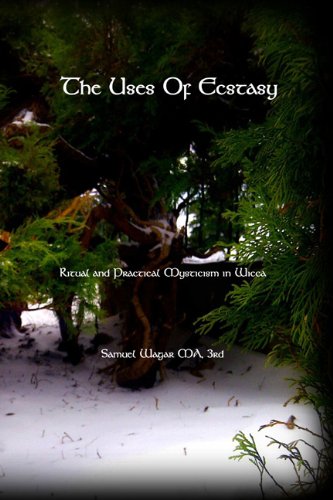Easily one of the most interesting books I've read in awhile,The Uses of Ecstasy by Samuel Wagar handles multiple subjects that lend themselves to charged, emotional arguments. His (somewhat ironic) analytical approach is actually perfectly-suited to this task, digging deep into subjects that are worthy of the examination while never giving you a reason to raise your hackles.That said, I think a trigger warning is order: while it is not the entire focus of the book, a substantial portion is an unsparing look at the Great Rite, including a sample ritual script. While he goes to great pains to draw distinction between (but not separate entirely - there is a relation) the sex act and the coupling of the Rite, several portions are explicit in venerating the Goddess with physical touch, particularly as preamble to the "finale". If such descriptions are likely to upset you then, whatever recommendation I might make, you should stay away. And as I've just hinted, I do think this is a worthy read in other respects.
One of the central themes of The Uses of Ecstasy is that in the practice of Wiccan religion, there is a real danger of the influences of the monotheistic religions and their practices to run roughshod over the ecstatic, trance-based ceremonies at the core of Wiccan traditions. After all, it is undeniable that most of those who practice witchcraft as adults are from families of other faiths; bringing along what we know of religious practice from our youth is almost inevitable. As Mr. Waygar takes pains to remind the reader, witchcraft has ecstatic trance-states at its very core. Even if your tradition has set aside the Great Rite, Drawing Down the Moon and Drawing Down the Sun are far more prevalent. In these rituals, some member of the group clears themselves out of the way, allowing the Goddess or God to enter them, speaking through them with the rest of the participants in more direct terms than usually possible. Such magic happens only very subtly, and rarely, in most other faiths. Embracing this aspect of witchcraft is vital, as explained by the author.
The first part of the book, "An Explanation and Understanding of Wiccan Ritual" is a thorough (exhaustive?) foundation, beginning with a section titled "Polytheology and Ethics" that was fascinating. Through this portion and the rest of part 1, he is laying an important foundation, guiding the reader to examine their own ethical foundation as it pertains to their faith. Of particular interest to me was the admonition against identifying too strongly with a single deity. Once this foundation is laid, he turns to part 2 which is focused entirely on the Great Rite. As this is a review and not a book report, I won't lay out everything he says on the subject, but in the times we live in I feel that two brief passages should be quoted.
"The Congregationalist Wiccan Association of British Columbia supports as an article of faith, as stated in the Charge of the Goddess, that "all acts of love and pleasure" are the Goddess' rituals. To us this means that any form of love or sexuality that is non-abusive, and non-coercive, between consenting adults, is acceptable and even desirable. This includes, but is not limited to, relationships that are heterosexual or homosexual, relationships that are monogamous or polyamorous, and relationships that are alternative or conventional."
"If the circumstances of someone's life, individual psychology or relationships do not permit a completely pragmatic approach to Great Rite, the norm need not be elevated into a religious principle in contradiction to Wicca's foundation principles. Acknowledging the central importance of the Great Rite does not make its performance mandatory. A Priestess or Priest who practiced Great Rite indiscriminately would be going counter to the spirit of it. The power of conscious choice of what a Pries/ess will do ritually is as significant in this regard as in any other."
I bring these passages to the reader's attention to highlight that, while Mr. Wagar makes it clear in no uncertain terms that he believes the Great Rite has pride of place in the center of Wiccan ritual practice, it is still something a participant must come to willingly, absent coercion or manipulation; to run counter to that is to undermine the very purpose of the ritual.
The third and final section broadens the examination of trance into other aspect of Wiccan theology, particularly Drawing Down the Moon and Drawing Down the Sun. While the section is of general interest, Mr. Wagar is particularly interested in, and spends a great deal of time on, the education and training of leaders so that they, then, can model the behaviors to those they support. It is, as the rest of the book is, short on fluff and long on background and detailed, practical advice for incorporating trance states more fully into your practice. The book concludes with a sample ritual script for the reader to adapt to their purposes, as well as an extensive bibliography. In all, I found The Uses of Ecstasy to be incredibly informative on a topic that doesn't get as much deep-diving as it should.
~ review by Patricia Mullen
Author: Samuel Wagar
Obscure Pagan Press, 2012
pp. 160
The Uses of Ecstasy: Ritual and Practical Mysticism in Wicca

©
2010 - 2024
Facing North
